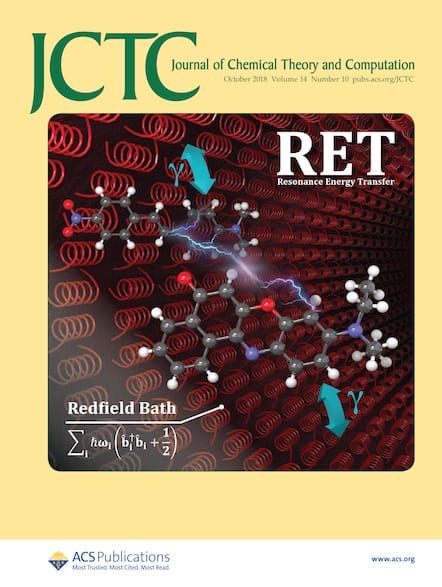Quasiclassical Doorway-Window Simulation of Femtosecond Transient-Absorption Pump-Probe Signals Beyond the Weak-Pump Limit.
IF 5.7
1区 化学
Q2 CHEMISTRY, PHYSICAL
引用次数: 0
Abstract
We developed an ab initio on-the-fly protocol for the simulation of transient-absorption strong-pump weak-probe signals by combining a trajectory surface hopping method with the classical doorway-window approximation. With this protocol, transient-absorption strong-pump weak-probe signals can be evaluated at about the same computational cost as weak-pulse transient-absorption pump-probe signals. The methodology is illustrated by the simulation of transient-absorption strong-pump weak-probe spectra of pyrazine, the weak-pulse pump-probe spectra of which were computed with the on-the-fly trajectory surface hopping─doorway-window method by Gelin et al., J. Chem. Theory Comput. 2021, 17, 2394. The effect of the intensity of the pump pulse on the transient-absorption strong-pump weak-probe spectra is investigated. In particular, it is demonstrated that the relative intensities of the ground-state bleach, stimulated emission, and excited-state absorption signals can be modified by variation of the strength of the pump pulse.超弱泵浦极限飞秒瞬态吸收泵浦探测信号的准经典门窗模拟。
我们将轨迹表面跳变方法与经典的门-窗近似相结合,开发了一种用于瞬态吸收强泵弱探测信号模拟的从头算动态方案。利用该协议,瞬态吸收强泵弱探测信号的计算成本与弱脉冲瞬态吸收泵探测信号的计算成本大致相同。通过模拟吡嗪的瞬态吸收强泵浦弱探测光谱来说明该方法,Gelin et al., J. Chem采用动态轨迹表面跳跃─门窗法计算了吡嗪的弱脉冲泵浦探测光谱。理论计算,2021,17,2394。研究了泵浦脉冲强度对瞬态吸收强泵浦弱探测光谱的影响。特别地,证明了基态漂白、受激发射和激发态吸收信号的相对强度可以通过泵浦脉冲强度的变化而改变。
本文章由计算机程序翻译,如有差异,请以英文原文为准。
求助全文
约1分钟内获得全文
求助全文
来源期刊

Journal of Chemical Theory and Computation
化学-物理:原子、分子和化学物理
CiteScore
9.90
自引率
16.40%
发文量
568
审稿时长
1 months
期刊介绍:
The Journal of Chemical Theory and Computation invites new and original contributions with the understanding that, if accepted, they will not be published elsewhere. Papers reporting new theories, methodology, and/or important applications in quantum electronic structure, molecular dynamics, and statistical mechanics are appropriate for submission to this Journal. Specific topics include advances in or applications of ab initio quantum mechanics, density functional theory, design and properties of new materials, surface science, Monte Carlo simulations, solvation models, QM/MM calculations, biomolecular structure prediction, and molecular dynamics in the broadest sense including gas-phase dynamics, ab initio dynamics, biomolecular dynamics, and protein folding. The Journal does not consider papers that are straightforward applications of known methods including DFT and molecular dynamics. The Journal favors submissions that include advances in theory or methodology with applications to compelling problems.
 求助内容:
求助内容: 应助结果提醒方式:
应助结果提醒方式:


